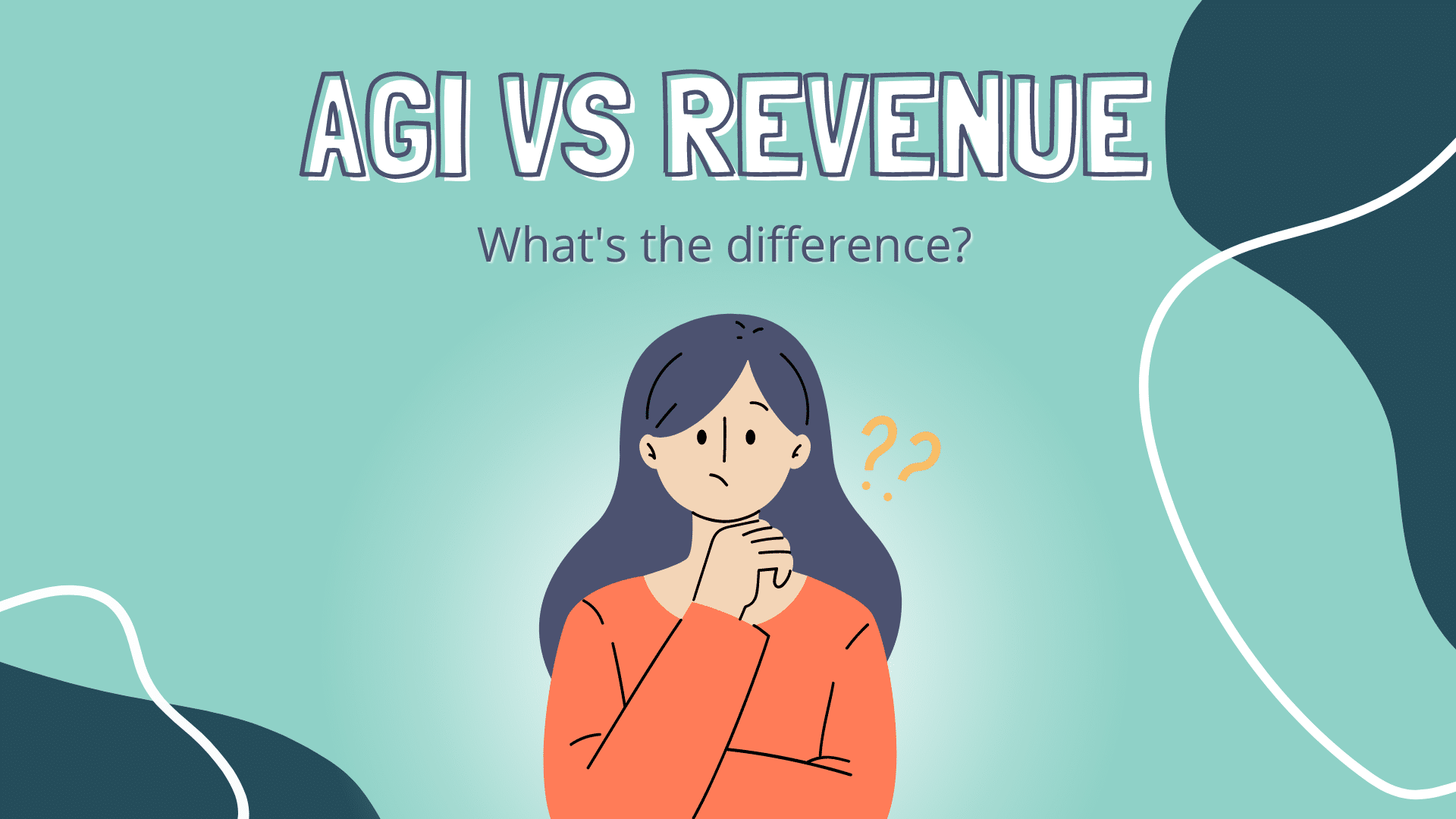In this article, we’re going to talk about why “Agency Gross Income” (AGI) is a better way to measure a service-based business’s success than just looking at their revenue. Basically, AGI takes into account all the expenses that the business has to pay in order to deliver their services, whereas revenue only looks at how much money is coming in the door.
Let’s go deeper.
AGI vs AGI?

First of all it’s important to clarify that there are two forms of AGI that you may hear about, and that can sound very similar to each other. In this article we will be advocating for the use of “Agency Gross Income”, which is calculated by taking your Revenue and removing all Pass-Through Expenses (don’t worry if that isn’t clear yet, we’ll explain it in more detail below). Another concept which uses the acronym of AGI is “Adjusted Gross Income”. Adjusted Gross Income is similarly calculated by taking your Revenue and removing certain deductions (one of which may also be Pass-Through Expenses), but this is typically a value that is more relevant in the calculation of taxes and is not related to the discussion here.
An Example: Adding Subcontracted Work To Engagements
Let’s set up an example that we’ll use throughout this article. Let’s assume that your agency is a design and marketing firm. You’ve built a business doing primarily brand creation related activities, but recently you’ve been doing more creative work around video ad spots for YouTube. So far you’ve focused purely on the creative, but have been encountering challenges with having the customer manage the sourcing and management of the production firms that would produce the spots.
You are considering attempting to bring the video production “in-house”, but instead of building out those capabilities within your firm (and the associated risks and challenges with building that new capability) you plan to subcontract that production work to partner firms. This will allow you to have more direct control over the production of your creative work and to ensure that the quality of that work does service to the quality of your creative work.
With your current product you typically charge around $30,000 for the creative work associated with an ad spot, and it takes your team around 200 hours of work across the strategy, design, and project management. We’ll refer to this as your “Creative” product.
You believe it will typically cost around $15,000 for the production of the ad, and figure it will probably take about 50 hours of additional time from your team to manage and coordinate with the video production team during the project. You’re planning to add an additional $5,000 of markup on top of the costs of the subcontracted work, for an overall project revenue of $50,000. We’ll call this your “Creative + Production” product.
Side note: our Agency Profit Toolkit is a one stop shop for you to be able to outline some of these crucial profitability numbers to a potential buyer. Spreadsheets, templates and training videos, you name it, it’s all in the toolkit. Grab yours free at the link below:
Where Revenue Falls Short; AGI As “Real” Income
As a service business the business model ultimately reduces to, first of all, attempting to drive as much income per hour of your teams time as possible (your Average Billable Rate), and secondly, to ensuring that your team is as consistently utilized as possible (your Utilization). If both of these fundamentals are healthy (and your expenses are reasonably in line) you will have a healthy, profitable business.
As with most things that sounds simple at first. However, there is nuance that inevitably emerges around these concepts. In the example above, we laid out two products your agency is considering selling. Each of these projects were expected to drive a certain amount of revenue, and require a certain amount of time from your team:
Creative Product: $30,000 Revenue, 200 hours
Creative + Production Product: $50,000 Revenue, 250 hours
In considering these two offerings, one of the key questions is which drives more income (per hour of your team’s time) for your agency over the other. This is in theory a fairly straightforward calculation, we just take the Revenue and divide it by the number of hours required to deliver the product. This would give us the following numbers for these products:
Creative Product: $30,000 Revenue / 200 hours = $150 Revenue/hour
Creative + Production Product: $50,000 Revenue / 250 hours = $200 Revenue/hour
This appears to show a pretty clear winner. The product that includes production earns us an extra 33% of Revenue for each hour of our team’s time. This initial result is misleading, however, and you may have already noticed the reason why. For the Creative product we get to keep all $30,000 of revenue to fund our team, our overhead, and ultimately our profit. For the Creative + Production product, $15,000 of the revenue basically comes in the door and then immediately goes out to our Video Production partner. It’s effectively much closer to a situation where we really only had $35,000 ($50,000 – $15,000) of Revenue from the project. This is exactly what is meant by Agency Gross Income, the Revenue you have left after any of those Pass-Through Expenses (that have come in the front door and immediately gone out the back door) are paid. Taking that into account, we see a different picture:
Creative Product: $30,000 AGI / 200 hours = $150 AGI/hour
Creative + Production Product: $35,000 AGI / 250 hours = $140 AGI/hour
Accounting for the “Real” income that truly belongs to your agency (and isn’t just being held temporarily on the way to someone else) we see a very different picture. Not only does that 33% premium disappear, you will actually make $10 less for each hour of your team’s time than with your current project.
Using AGI As An Expense Benchmark
Hopefully from the example above it’s pretty apparent why Pass-Through Expenses that flow through your agency are really a form of illusory Revenue. Just as they can give you a false sense of how profitable various products and projects are, it can give you a false sense of how large your agency is, and consequently what levels of expenses are appropriate.
In some business models as much as half of your Revenue could be Pass-Through Expenses. After you’ve removed your Pass-Through, the AGI that’s left is ultimately what will need to cover all your expenses.
Here are two example agencies, both with the same expenses relative to their Revenue, but very different expenses relative to AGI, and consequently very different outcomes in terms of profit:
| Agency A | Agency B | |||
| % Revenue | $ | % Revenue | $ | |
| Revenue | 100% | $5,000,000 | 100% | $2,500,000 |
| Pass-Through | 50% | $2,500,000 | 0% | $0 |
| AGI | 50% | $2,500,000 | 100% | $2,500,000 |
| Delivery Expenses | 50% | $2,500,000 | 50% | $1,250,000 |
| Overhead Expenses | 25% | $1,250,000 | 25% | $625,000 |
| Net Income | -5% | -$1,250,000 | 25% | $625,000 |
Closing Thoughts
When expenses are benchmarked against Revenue, they are benchmarked against a metric that can become decoupled from the “Real” income an agency earns that ultimately has to fund its expenses. This is why your expenses should instead be benchmarked against Agency Gross Income.





Hi guys! Nice blog. I have a question about calculating the AGI.
AGI = Revenue -/- Pass trhough costs.
But what to do if there is a mark up on the pass trhough costs?
Example:
Hiring Equipment
Revenue 1.000
COGS 500
Margin 500
Then there is a inhouse cameraman where we charge 2.000 for.
Is the AGI then 500 + 2.000 = 2.500 ? In that case the AGI includes the margin on material. If you benchmark 50% delivery costs, it doesn’t make sence on the performance on you inhouse team right?
What should you suggest?
Hey Nick! Glad you’re enjoying the blog and thanks for a great question.
The simple answer is, Markup should be reflected in AGI – and Delivery Margin is always a reflection of delivery costs relative to AGI.
That said, markup is really a pricing concept so we need to be clear about whether or not it’s increasing AGI.
Let’s look at an example:
We have a project that we’re charging the client $20,000 for
We have internal delivery costs of $5,000 on this project
We have pass-through expenses amounting to another $3,000
In this case, our AGI is $17,000 ($20,000 Revenue – $3,000 Pass-Through expenses)
Our Delivery Margin is about 70% ($17,000 AGI – $5,000 Delivery Costs) / $17,000 AGI
There are several ways we can present this project to the client:
1. The price for this project is $20,000
2. The price for this project is $17,000 + $3,000 in production expenses
3. The price for this project is $15,000 + 3,000 in production expenses and $2,000 in markup
4. The price for this project is 100 hours at $200/hr
5. The price for this project is 4 sprints at $5,000 per sprint
6. Etc.
In each of these cases, the underlying math for Revenue, Pass-Through Expenses, AGI, and Delivery Margin are exactly the same and have not changed. This illustrates that “Markup” is simply a pricing concept, and not a scoping concept. In this case, using “markup” doesn’t actually change the price, nor does it change the true economics of the project, it just changes how we talk about the price with the client.
With that said, in the event that Markup increases the price we can charge to a client without increasing the scope, it would have an impact on our AGI and delivery margin.
Let’s take the same example from above, but imagine that we’re charging a 30% markup on pass-through costs in addition to the $20,000 price we would have otherwise charged.
In this case, instead of charging the client $20,000, we’re now charging them $20,900
Our AGI then increases to $17,900 ($20,900 – $3,000)
Our delivery margin increases to 72% ($17,900 – $5,000) / $17,900
As you can see, in this case the additional “markup” has flowed through to AGI.
The big idea here is that “markup” as a concept is generally meant to create additional compensation for the agency to help them compensate for the time that is required to manage the pass-through expenses and/or cover the additional labor required to manage the project as a whole. My assumption in this example is that applying markup to the project doesn’t change the underlying scope (meaning the amount of time required to get the project done isn’t changing). Since we subtract only pass through expenses any markup would flow through to AGI and would be reflected in delivery margin.
Does that answer your question?